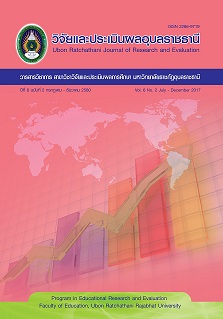An Operation on Development of Proactive Learning for Developing Learning Retention on “Photosynthesis” of Matthayom Suksa 5 Students at Nachaluay School under the Secondary Educational Service Area Office 29
Keywords:
Proactive Learning Management, Learning RetentionAbstract
The purposes of this study were to: (1) develop proactive learning management in biology; (2) compare the learning achievement after learning with the criterion; (3) compare the learning achievement before and after learning; and (4) compare learning retention by proactive learning and by the teacher’s manual with the criterion of not less than 80%. The samples were 60 Mathayom Suksa 5 students selected by cluster random sampling. The instruments were: (1) learning plans, (2) test,
(3) an achievement test, (4) an observation form, and (5) a student’s interview form. The statistics were percentage, mean, standard deviation, and t-test.
The research findings were as follows:
- The operation on developing the proactive learning in biology had three spiral cycles with three stages: (1) Planning (2) Operation and Observation, and (3) Reaction. Each cycle consisted
of these activities: (1) checking prior knowledge, (2) encouragement, (3) surveying, (4) explaining, (5) expanding knowledge, (6) evaluation, and (7) application. - The students taught by proactive learning management had significantly higher scores after the operation than before the operation at the critical level .01. The post-test scores of the students taught by proactive learning management were significantly higher than those taught by the teacher’s manual at the critical level .01.
- The students taught by the proactive learning management had significantly higher learning retention than those taught by the teacher’s manual at the critical level .01.
References
ชัยณรงค์ แก้วสุข. ผลของการเรียนการสอนชีววิทยาโดยใช้รูปแบบ ED3U ร่วมกับคอมพิวเตอร์สถานการณ์จำลองที่มีต่อทักษะกระบวนการทางวิทยาศาสตร์และความคงทนในการเรียนรู้ของนักเรียนมัธยมศึกษา
ตอนปลาย. วิทยานิพนธ์ครุศาสตรมหาบัณฑิต จุฬาลงกรณ์มหาวิทยาลัย, 2550.
วิชาการ, กรม. การวิจัยเพื่อพัฒนาการเรียนรู้ตามหลักสูตรการศึกษาขั้นพื้นฐาน. กรุงเทพฯ: โรงพิมพ์คุรุสภาลาดพร้าว, 2545.
วิทยา มิหอมมิ. ผลสัมฤทธิ์ทางการเรียนและความคงทนในการเรียนวิชาคอมพิวเตอร์ที่เรียนด้วยกิจกรรม
การเรียนรู้เชิงรุก ร่วมกับเครือข่ายสังคมออนไลน์ของนักเรียนชั้นมัธยมศึกษาปีที่ 4. วิทยานิพนธ์
ศึกษาศาสตรมหาบัณฑิต มหาวิทยาลัยทักษิณ, 2558.
วันเพ็ญ คำเทศ. ผลของการเรียนการสอนชีววิทยาโดยใช้รูปแบบการเรียนรู้เชิงรุกของเลสไล ดีฟิงค์ ที่มีต่อความสามารถในการเขียนอนุเฉทและผลสัมฤทธิ์ทางการเรียนของนักเรียนมัธยมศึกษาตอนปลาย. วิทยานิพนธ์ครุศาสตรมหาบัณฑิต จุฬาลงกรณ์มหาวิทยาลัย, 2549.
ศิริพร มโนพิเชษฐวัฒนา. การพัฒนารูปแบบการจัดการเรียนการสอนวิทยาศาสตร์แบบบูรณาการที่เน้นผู้เรียน
มีส่วนร่วมในการเรียนรู้ที่กระตือรือร้น เรื่องร่างกายมนุษย์. ปริญญานิพนธ์การศึกษาดุษฎีบัณฑิต มหาวิทยาลัยศรีนครินทรวิโรฒ, 2547.
ส่งเสริมการสอนวิทยาศาสตร์และเทคโนโลยี, สถาบัน. การจัดสาระการเรียนรู้กลุ่มวิทยาศาสตร์หลักสูตรการศึกษาขั้นพื้นฐาน. กรุงเทพฯ: สถาบันส่งเสริมการสอนวิทยาศาสตร์และเทคโนโลยี, 2547.
. การจัดสาระการเรียนรู้กลุ่มวิทยาศาสตร์หลักสูตรการศึกษาขั้นพื้นฐาน. กรุงเทพฯ: สถาบันส่งเสริมการสอนวิทยาศาสตร์และเทคโนโลยี, 2546.
สุวิมล ว่องวาณิช. การวิจัยปฏิบัติการในชั้นเรียน. กรุงเทพฯ: อักษรไทย, 2545.
อุบลวดี อดิเรกตระการ. การเปรียบเทียบผลสัมฤทธิ์ทางการเรียนและเจตคติต่อวิชาเคมี เรื่อง ปริมาณสัมพันธ์ ของนักเรียนชั้นมัธยมศึกษาปีที่ 4 โดยการจัดการเรียนรู้แบบกระตือรือร้นกับแบบปกติ. วิทยานิพนธ์ครุศาสตรมหาบัณฑิต มหาวิทยาลัยราชภัฏเทพสตรี, 2557.
Downloads
Published
How to Cite
Issue
Section
License
1. บทความที่ตีพิมพ์ในวารสารนี้ได้มีการตรวจสอบการลอกเลียนงานวรรณกรรมแล้ว ไม่เกินร้อยละ 25
2. บทความที่ตีพิมพ์ในวารสารนี้เป็นข้อคิดเห็น ข้อค้นพบของผู้เขียนบทความ โดยผู้เขียนบทความต้องเป็นผู้รับผิดชอบต่อผลทางกฎหมายใด ๆ ที่อาจเกิดขึ้นจากบทความนั้น ๆ
3. บทความ ข้อมูล เนื้อหา รูปภาพ ฯลฯ ที่ได้รับการตีพิมพ์ในวารสารวิจัยและประเมินผลอุบลราชธานี ถือเป็นลิขสิทธิ์ของวารสารวิจัยและประเมินผลอุบลราชธานี หากบุคคลหรือหน่วยงานใดต้องการนำทั้งหมดไปเผยแพร่ต่อหรือเพื่อกระทำการใดๆ จะต้องได้รับอนุญาตเป็นลายลักษณ์อักษรจากวารสารวิจัยและประเมินผลอุบลราชธานีก่อนเท่านั้น และจะต้องมีการอ้างอิงวารสารวิจัยและประเมินผลอุบลราชธานี ฉบับนั้น ๆ ด้วย






